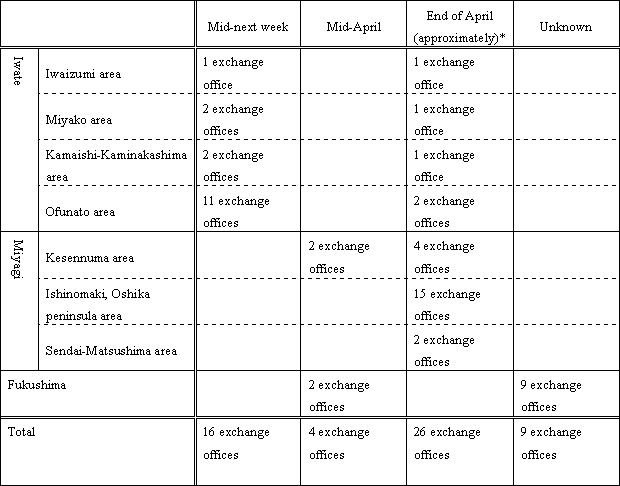| (1) |
Status of the impact on communication facilities
The current status of damage to the main communication facilities are as follows.
| <1> |
Relay transmission lines
-Disconnected in 90 routes |
| <2> |
Exchange office building
-Demolished: 18 buildings
-Submerged: 23 buildings |
| <3> |
Destruction by flood and collapse of telephone poles
-Approximately 65,000 poles (coastal region) |
| <4> |
Submersion and physical damage to aerial cables
-Approximately 6,300 kilometers (coastal region) |
|
| (2) |
Restoration efforts on communication facilities (facilities within exchange offices, transmission lines between exchange offices)
<1>
Efforts undertaken so far
The earthquake and tsunami disrupted commercial power supply and caused equipment failure in approximately 1,000 exchange offices. NTT East responded by deploying emergency batteries, emergency power generators and mobile power supply vehicles to provide power. However, some exchange offices remained inoperable, resulting in the disruption of a total of approximately 1.5 million circuits at maximum in telephone subscriber lines, ISDN and FLET’S Hikari (FTTH) services as of March 13.
Under these circumstances, NTT East has thus far, with the help of other NTT group companies and construction companies, mobilized a total of some 6,000 people to make an all-out effort to restore these services. By 1:00 p.m., March 28 (JST), approximately 95 percent of the exchange offices have been restored along with the recovery of commercial power supply, leaving 55 dysfunctional exchange offices and approximately 110 thousand affected circuits remaining to be restored.
Number of circuits with communication service failures

| Note: |
Figures exclude failures due to circuit disruptions between customer homes and NTT East exchange offices. |
<2>Status of the impact on exchange offices with discontinued services
The damage and restoration status of the exchange offices with discontinued services (55 buildings) as of March 28 are as follows.

| * |
Details will be announced separately once the timing of restoration is confirmed. |
Also, if the degree of damage is assessed as “C” and municipal government office buildings are located within the area of an applicable exchange office, as a general rule, stopgap repair measures will be implemented within a week and public administration and other important circuits will be restored (5 buildings).
Forecasted number of days needed for restoration of services in exchange offices with discontinued services

| Note: |
The end of April is targeted, but there may be a delay depending on the situation. Details will be announced separately once the timing of restoration is confirmed. |
|
| (3) |
Efforts to restore communication facilities (outdoor facilities)
Telephone poles, communication cables and other facilities outside NTT exchange offices suffered significant damage due to the earthquake and tsunami. Immediately after the earthquake, it was difficult to inspect these facilities as restricted areas were set and traffic controls applied, but as these restrictions were rescinded, NTT East has been confirming the conditions in these areas using helicopters and other means, and will direct its efforts towards service restoration going forward in accordance with the damage situation and the reconstruction of the cities.
|
| (4) |
Organization for restoration, etc.
After the earthquake struck, NTT East established a Disaster Countermeasures Office in its headquarters office, as well as Disaster Countermeasure Offices in the stricken prefectures, thus creating an organizational structure capable of close collaboration 24-hours-a-day. With a team of approximately 5,000 people, these Disaster Countermeasure Offices then commenced efforts to understand the extent and nature of the damage and initiate restoration.
Among others, in Iwate, Miyagi and Fukushima, the three prefectures where the damage was the greatest, a wide-area support structure was built, with staff dispatched from headquarters and other branch offices, as well as receiving assistance from NTT West and other group companies. Currently, a team of approximately 6,000 people are handling the restoration efforts.
(To address full restoration of services, it is planned that telecommunication construction companies will be added to the team to reinforce these efforts going forward.)
|
| (5) |
Efforts to support the affected people
<1>Provision of Disaster Emergency Message Dial, etc.
Since the earthquake, NTT East has been providing safety confirmation services “Disaster Emergency Message Dial 171” and “Disaster Emergency Broadband Message Board (Web 171)” to be used by those affected by the earthquake. As of 1:00 p.m. on March 28 (JST), “171” has been used approximately 3.17 million times cumulatively and “Web 171” approximately 0.24 million times cumulatively.
<2>Deployment of free public telephones, etc.
To secure a means of communication for people affected by the earthquake, NTT East has installed in 738 locations 2,308 special public telephones that are available for use free of charge (as of 12:00 noon, March 28 (JST)). This accommodation has been implemented in almost all locations requested by local governments.
Also, NTT East made the existing public telephones in the six prefectures located within the Tohoku region available for use free of charge immediately after the earthquake. At 7:00 p.m. on March 11 (JST), 122,000 public telephones across the entirety of Eastern Japan were made available for use free of charge. Currently, following the lifting of call restrictions, public telephones remain free in Iwate, Miyagi and Fukushima.
<3>Waiver of telephone charges, etc.
For customers who were actually unable to use their telephones or broadband services due to the earthquake, the basic charges for those periods, as well as service relocation costs when moving in to temporary housing, will be waived and the payment deadline for telephone and other charges will be extended.
<4>Others
| - |
Installation of free Internet connection stations at evacuation shelters, etc.
Free Internet connection stations have been installed at evacuation shelters in 12 prefectures (138 stations) (of which 63 stations have Wi-Fi environment).
|
| - |
Taking messages from people in damaged areas
NTT East staff members deliver messages, on behalf of affected people, to their families, and if the family members are away from home, NTT East registers their messages on the Disaster Emergency Message Dial on their behalf. |
|
|